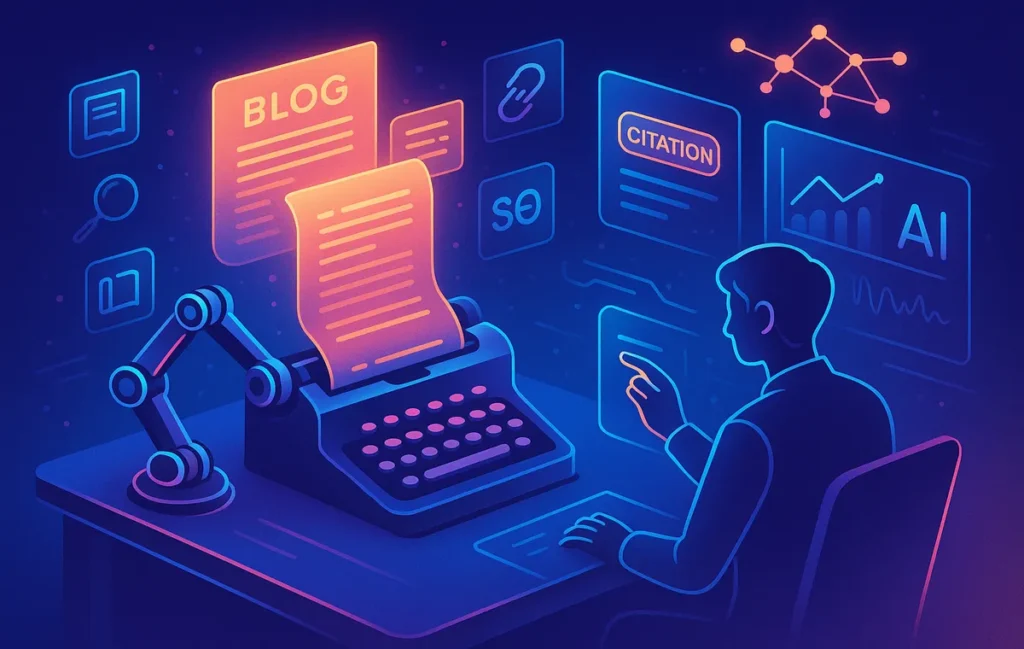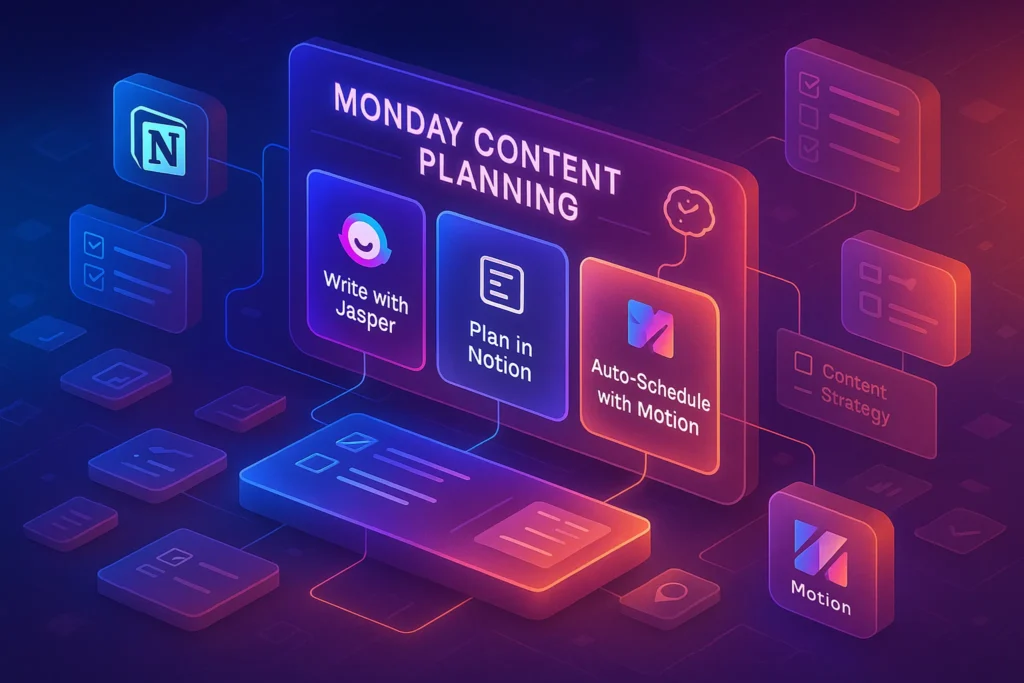✍️ Intro:
The conversation around AI in blogging has shifted. In 2023, the excitement was about speed—AI could churn out 1,000 words in seconds. By 2025, the discussion is no longer about “Can AI write?” but rather “Can AI write well, cite accurately, and survive detection without hurting SEO?”
For bloggers, marketers, and small businesses, the rise of AI blog writers is both a blessing and a minefield. On one hand, tools like ChatGPT and Jasper have evolved into capable long-form content generators with near-human readability. On the other, search engines and academic platforms have raised the bar on E-A-T (Expertise, Authoritativeness, Trustworthiness), penalizing shallow or unverified AI content.
💡 Nerd Tip: AI writing isn’t just about output—it’s about crafting posts that stand up to scrutiny, deliver real value, and respect the rules of SEO.
📚 Quality in the Age of AI Blog Writers
Quality is the currency of credibility. While early AI outputs often felt formulaic, modern AI writers in 2025 generate text that flows with coherence, narrative depth, and even contextual storytelling. Yet, quality isn’t just about word count—it’s about readability, structure, and usefulness.
For example, a 3,000-word article on content marketing generated by AI may hit all the right keywords but fail if paragraphs feel disconnected or repetitive. Successful bloggers are now blending AI drafts with human editing, ensuring logical flow and brand voice.
User feedback supports this: one creator posted on X,
“AI gives me the skeleton, but I still need to flesh out the muscle. Readers spot robotic tone instantly.”
Platforms like Best AI Writing Tools for Bloggers now emphasize not only generation but also features like tone control, style training, and long-form consistency. This evolution reflects the demand for AI that acts less like a robot and more like a trained writing assistant.
💡 Nerd Tip: Always run AI drafts through a readability check. Long-form content that is technically accurate but exhausting to read won’t build loyal audiences.
🔗 The Challenge of Citations & Factual Accuracy
Perhaps the greatest weakness of AI blog writers remains citations and fact reliability. AI often “hallucinates,” fabricating references or mixing outdated facts with confidence. In 2024, several universities reported students citing non-existent articles generated by large language models.
By 2025, premium AI blog writers introduced factuality modules that cross-check claims against live databases. Jasper, for instance, now flags statements that need verification, while other platforms integrate citation builders that pull from real academic journals or trusted news sources.
Still, responsibility rests with the human writer. A tech blogger using an AI tool to cover SEO trends discovered that half the cited statistics were from 2018—irrelevant to today’s algorithms. Without manual verification, credibility collapses.
This is particularly important for SEO. Google’s E-A-T standards scrutinize sources, and citing vague “studies” without links can lead to penalties. That’s why at NerdChips, we stress the importance of verifying every data point before hitting publish.
💡 Nerd Tip: Never let AI invent your sources. Fact-check, update, and replace hallucinated citations with credible references.
🕵️ AI Detection in 2025: Can You Outsmart the Watchdogs?
AI detection has become its own arms race. Tools like GPTZero, Originality.AI, and Copyleaks scan for patterns in sentence probability and text predictability. In 2023, simple paraphrasing could fool them. In 2025, detection tools now combine linguistics with metadata analysis, sometimes even cross-referencing publication timestamps and API fingerprints.
For bloggers, this raises a dilemma: content that “looks too AI” risks SEO suppression or platform rejection. Many creators now use human-in-the-loop editing or hybrid workflows: draft with AI, refine with human nuance, then run through a detection scanner before publishing.
But detection isn’t perfect either. False positives are a real risk. Writers on X frequently share frustration:
“Originality.AI flagged my 100% human draft as 92% AI-written. Imagine explaining that to a client.”
This means bloggers need balance. Instead of chasing invisibility, the smarter move is to embrace transparency: combine AI efficiency with human oversight, and disclose AI assistance when necessary. Readers trust honesty more than perfection.
💡 Nerd Tip: Don’t obsess over fooling detection—obsess over creating value. Even Google says its priority is quality, not origin.
⚠️ SEO Risks: AI Content and E-A-T in 2025
The SEO landscape has been reshaped by AI. Google’s core updates in 2024 and 2025 made it clear: low-value AI spam won’t survive. Blogs that scaled purely on quantity—churning out dozens of auto-written posts a day—saw rankings collapse.
The risk isn’t AI itself—it’s how it’s used. High-quality, human-edited AI posts can thrive, but content that lacks citations, originality, or insights risks violating E-A-T standards. An AI blog writer might nail keyword density but miss topical authority, leading to cannibalization or weak ranking signals.
That’s why building topical clusters matters. A blog post on AI writers, for example, should naturally link to posts like Can AI Really Write Your Next Post? or The Future of Content Creation, building authority across the subject.
💡 Nerd Tip: Treat AI as a draft partner, not a publishing autopilot. Google rewards value density, not volume.
🧩 The Role of Human Editors
Even in 2025, human editors remain indispensable. Their job is less about writing from scratch and more about shaping AI drafts into trustworthy narratives. They add:
-
Brand voice consistency.
-
Verified citations.
-
Cultural nuance and emotional resonance.
-
Contextual linking to build SEO authority.
Think of AI as the engine, but editors as the steering wheel. Without one, the other risks veering off course.
💡 Nerd Tip: The best-performing blogs are not “AI-written” or “human-written”—they are AI-assisted, human-refined.
⚡ Ready to Build Smarter Workflows?
Explore AI blog writing tools that balance quality and credibility. Learn how to combine automation with citations, editing, and SEO strategy.
⚠️ When AI Blog Writing Fails
Not every AI-written blog succeeds. In fact, some failures have already become cautionary tales. A news-focused blog in 2024 scaled aggressively, publishing over 1,000 AI-generated articles without human editing. For a few months, traffic exploded—but when Google rolled out its Helpful Content Update, the site lost 90% of its organic traffic overnight. The reason? Thin content, poor citation practices, and obvious repetition.
Another failure came from a niche health site that published AI-written advice without fact-checking. The AI hallucinated a medical citation, attributing a treatment to a non-existent study. Once readers spotted the mistake, the brand’s trust collapsed. For sensitive niches, this kind of error can mean more than lost traffic—it can damage lives.
💡 Nerd Tip: The biggest danger of AI writing isn’t quality at first glance—it’s credibility collapse when errors are exposed.
📐 Mini Comparison Snapshot
Here’s how some of the leading AI blog writing tools stack up in 2025 when judged on long-form quality, citation handling, and AI detection risk:
| Tool | Long-Form Quality | Citation Handling | AI Detection Risk |
|---|---|---|---|
| Jasper | High (brand voice training) | Citation flagging but manual check needed | Medium |
| Writesonic | Strong readability, creative tone | Limited source linking | High |
| Copy.ai | Good for marketing blogs | Weak citation accuracy | High |
| ChatGPT Pro (customized) | Excellent coherence | Can integrate with factual plugins | Low–Medium |
This snapshot reveals a key truth: the “best” AI writer depends on your priorities. If you need polished tone, Jasper wins. If citations matter, a GPT-based tool with plugins is safer. If speed is everything, Writesonic might suffice—but with higher detection risks.
💡 Nerd Tip: Don’t pick AI writers on features alone—match them to your niche’s risk profile (health, finance, tech, etc.).
🌌 What’s Next for AI Blog Writers Beyond 2025
The AI writing journey is only beginning. Looking beyond 2025, three major shifts are already on the horizon:
-
Hybrid Workflows as the Standard
The idea of “AI-only” writing is fading. The most successful blogs will blend AI drafts with human editors who handle nuance, fact-checking, and brand positioning. Think of it as co-writing rather than outsourcing. -
Verified Source Plug-ins
Tools are racing to integrate citation engines that pull directly from trusted sources. Imagine writing a blog post where the AI not only generates claims but automatically attaches links to real academic studies, news articles, or official reports. This will dramatically reduce hallucinations. -
AI Watermarking & Content IDs
Governments and search engines are discussing watermarking standards for AI-generated text. This means by 2026, every AI draft might carry an invisible fingerprint. For bloggers, this could make transparency a requirement, not a choice.
💡 Nerd Tip: Future-proof your blog now by building trust signals—citations, human editors, and transparency—so detection tech strengthens rather than punishes your brand.
📈 Case Study: Scaling with AI + Human Editing
A digital marketing agency in London provides a great example of how to use AI blog writers wisely. In early 2024, they adopted Jasper and ChatGPT to draft blog posts for clients. Instead of publishing drafts raw, they built a three-step workflow:
-
AI first draft to generate structure and flow.
-
Editor refinement for citations, tone, and SEO optimization.
-
Final brand check to ensure voice alignment.
Within six months, the agency tripled its content output while maintaining client satisfaction. Their organic traffic grew by 47%, and client retention rates rose.
On the other hand, a fintech blog tried to scale content purely with unedited AI drafts. The result was a spike in AI detection flags and a noticeable dip in rankings for competitive terms like “best credit card for freelancers.” Once they introduced a human fact-checking layer, recovery began.
These contrasting outcomes highlight the real lesson: AI doesn’t replace editorial discipline—it amplifies it when used correctly.
💡 Nerd Tip: Treat AI as a “content accelerator,” not a “content autopilot.” The return comes from pairing speed with credibility.
📬 Want More Smart AI Tips Like This?
Join our free newsletter and get weekly insights on AI tools, no-code apps, and future tech—delivered straight to your inbox. No fluff. Just high-quality content for creators, founders, and future builders.
🔐 100% privacy. No noise. Just value-packed content tips from NerdChips.
🧠 Nerd Verdict
In 2025, AI blog writers are no longer novelties—they are mainstream collaborators. The real question is not whether AI can generate text, but whether bloggers can ensure that text is coherent, well-cited, and trustworthy under SEO scrutiny. The winners will be those who treat AI as a powerful ally while maintaining editorial standards that protect credibility.
At NerdChips, our perspective is clear: AI blog writing is sustainable only when paired with human editing, factual verification, and strategic SEO. Otherwise, the short-term gains are wiped out by long-term penalties.
❓ FAQ: Nerds Ask, We Answer
💬 Would You Bite?
If you had to choose between faster AI output or stricter human editing, where would you place your bet for long-term blogging success?
Crafted by NerdChips for creators and teams who want their best ideas to travel the world.



